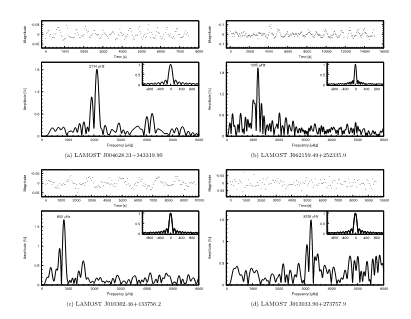Recently, LAMOST users Jie Su and Jianning Fu discovered four new DA pulsating white dwarfs based on data from the Large Sky Area Multi-Object Fiber Spectroscopic Telescope (LAMOST).
White dwarfs are the final evolutionary stage of low- and medium-mass stars. They are stellar remnants composed mostly of electron degenerate matter. About 98% of stars in the universe are expected to evolve into white dwarfs. They thus present an important boundary condition for investigating the previous evolution of stars. Meanwhile, white dwarfs are ready-made laboratories for studying physical processes under extreme conditions. More than 80% of white dwarfs are classified under the spectral type of DA, which have hydrogen-rich atmospheres. When the DA white dwarfs evolve and pass through the instability strip, which is located in a narrow range of effective temperature between 12,500 and 10,500 K, pulsations are excited. They become pulsating white dwarfs and present brightness variations. DA pulsating with dwarfs are also called DAV or ZZ Ceti stars. By detecting the pulsating modes and matching them to those of theoretical models, one can probe the invisible interior of a white dwarf to get information about its composition and internal structure, and then determine its stellar parameters. There are a total of about 200 pulsating white dwarfs were identified to date. In order to enlarge the sample, the search for new pulsating white dwarfs is necessary.
The candidates of DA pulsating with dwarfs were selected from the published catalogs by considering whether their effective temperature are situated in the instability strip. The follow-up time-series photometric observations for the candidates were performed in 2015 and 2016 with the two 2 m class telescopes in China: the 2.4 m telescope at Lijiang and the 2.16 m telescope at Xinglong. Four stars: LAMOST J004628.31+343319.90, LAMOST J062159.49+252335.9, LAMOST J010302.46+433756.2, and LAMOST J013033.90+273757.9 are confirmed to be new DA pulsating white dwarfs. The light curves of the four stars and the corresponding Fourier amplitude spectra are shown in Figure 1. They show dominant peaks with amplitudes rising above the 99.9% confidence level in the amplitude spectra.
The paper which describes this work, titled “New ZZ Ceti Stars from the LAMOST Survey”, had recently accepted for publication in The Astrophysical Journal. The link to the preprint of the paper ishttps://arxiv.org/abs/1708.07253.

Figure 1. Light curves and the corresponding Fourier amplitude spectra of the four new DA pulsating white dwarfs. (a) LAMOST J004628.31+343319.90, (b) LAMOST J062159.49+252335.9, (c) LAMOST J010302.46+433756.2, and (d) LAMOST J013033.90+273757.9. The number in each amplitude spectrum indicates the frequency of the dominant peak.

Address: 20A Datun Road, Chaoyang District, Beijing, China code: 100012
Tel: 010-64888708 E-mail: naoc@nao.cas.cn

